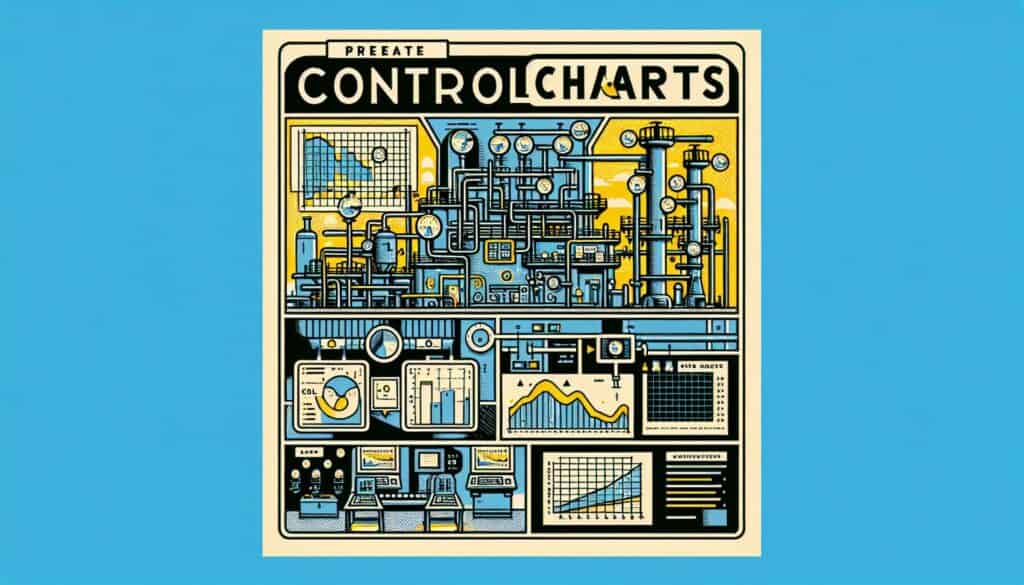Verhinderung der Herstellung nicht konformer Produkte durch Überwachung der Prozesseinstellungen beim Anfahren und während des Betriebs unter Verwendung breiterer Zonen als bei Regelkarten.
- Methodologien: Maschinenbau, Qualität
Vorab-Kontrolltabellen

Vorab-Kontrolltabellen
- Kontinuierliche Verbesserung, Fehlervermeidung, Schlanke Fertigung, Prozess-Fähigkeit, Prozessverbesserung, Produktionseffizienz, Qualitätssicherung, Qualitätskontrolle, Statistische Prozesskontrolle (SPC)
Zielsetzung:
Wie es verwendet wird:
- Ein einfaches statistisches Hilfsmittel, bei dem die Bediener eine kleine Anzahl aufeinanderfolgender Teile anhand von Grenzwerten überprüfen, die in grüne (Mitte), gelbe (Vorsicht) und rote (Stopp) Zonen unterteilt sind. Je nachdem, wohin die Teile fallen, werden Anpassungen vorgenommen.
Vorteile
- Simple to understand and use by operators; Provides immediate feedback on process stability; Focuses on defect prevention rather than just detection; Requires less data collection than traditional SPC charts.
Nachteile
- Weniger statistisch rigoros als Shewhart-Regelkarten; kann kleine Prozessverschiebungen nicht so gut erkennen; hängt stark von der Disziplin des Bedieners und der richtigen Interpretation ab.
Kategorien:
- Herstellung, Qualität
Am besten geeignet für:
- Providing a simple, operator-driven method for Prozesskontrolle at the point of manufacture, particularly useful for short runs or where full SPC is impractical.
Pre-Control Charts serve as an effective tool for quality management and can be particularly advantageous in industries such as automotive, electronics, textiles, and food processing, where production often involves a significant number of distinct parts produced in short runs. This methodology is often utilized during the manufacturing phase, particularly in environments where rapid adjustments are necessary due to fluctuations in production or when implementing new processes. Operators and front-line workers, who are familiar with the production intricacies, typically initiate this approach, allowing for prompt decision-making based on real-time data. The simplicity of Pre-Control Charts makes them accessible for users without advanced statistical training, providing immediate visual cues through a straightforward color-coded system that delineates acceptable and unacceptable performance. This enables teams to engage more actively in the monitoring process, fostering a culture of defect prevention rather than merely waiting for issues to be identified through more extensive Statistische Prozesskontrolle (SPC) mechanisms. Since the methodology requires less rigorous data collection, it allows companies to allocate resources efficiently, minimizing downtime and increasing responsiveness to quality issues. Furthermore, firms may find that integrating Pre-Control Charts into their workflows not only improves process reliability but also enhances the overall skill set of their workforce, empowering operators to take ownership of quality outcomes while effectively collaborating across departments for continuous improvement initiatives.
Die wichtigsten Schritte dieser Methodik
- Define the specification limits for the product.
- Determine the number of consecutive parts to be checked.
- Inspect each part against the defined limits.
- Classify the results into green, yellow, or red zones based on specifications.
- Implement immediate adjustments if parts fall into yellow or red zones.
- Continue monitoring the process and inspecting subsequent parts.
Profi-Tipps
- Ensure clear criteria for green, yellow, and red zones, involving operators in the definition process to enhance ownership.
- Implement regular training on reading and interpreting Pre-Control Charts to maintain operator engagement and competence.
- Utilize historical data to set realistic specification limits, allowing for continuous adjustments based on verified performance trends.
Verschiedene Methoden lesen und vergleichen, Wir empfehlen die
> Umfassendes Methoden-Repository <
zusammen mit den über 400 anderen Methoden.
Ihre Kommentare zu dieser Methodik oder zusätzliche Informationen sind willkommen auf der Kommentarbereich unten ↓ , sowie alle ingenieursbezogenen Ideen oder Links.
Historischer Kontext
1962
1970
1972
1980
1980
1986
1986
1960
1963
1970
1980
1980
1980
1986
1987
(wenn das Datum nicht bekannt oder nicht relevant ist, z. B. "Strömungsmechanik", wird eine gerundete Schätzung des bemerkenswerten Erscheinens angegeben)















Verwandte Artikel
Management der Produktionsabläufe (MOM)
Fertigungsausführungssystem (MES)
Produktionslenkungsplan
Manuelle Prüfung
Bewertungsbögen für die manuelle Handhabung (MAC)
ManTRA (Instrument zur Risikobewertung manueller Tätigkeiten)